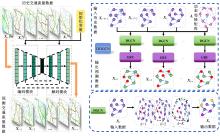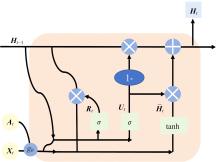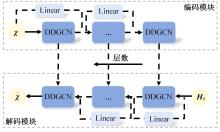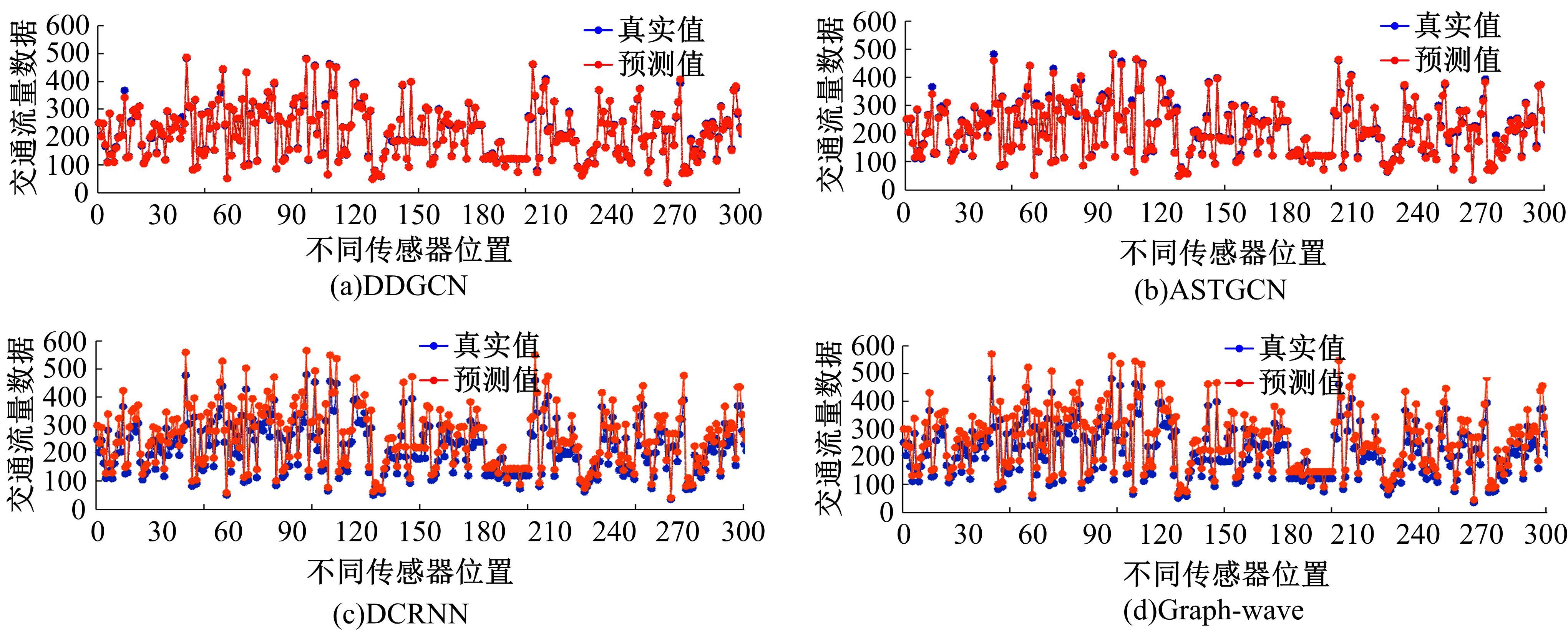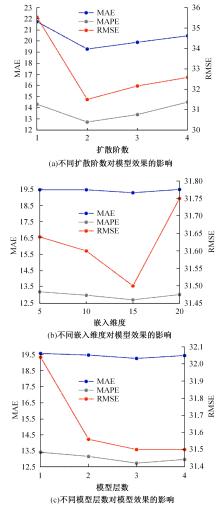吉林大学学报(工学版) ›› 2024, Vol. 54 ›› Issue (6): 1582-1592.doi: 10.13229/j.cnki.jdxbgxb.20220888
• 交通运输工程·土木工程 • 上一篇
基于动态扩散图卷积的交通流量预测算法
- 1.天津大学 电气自动化与信息工程学院,天津 300072
2.天津市测绘院有限公司,天津 300072
3.广西财经学院 大数据与人工智能学院,南宁 530001
Traffic flow prediction algorithm based on dynamic diffusion graph convolution
Pei-guang JING1( ),Yu-dou TIAN1,Shao-chu WANG2,Yun LI3(
),Yu-dou TIAN1,Shao-chu WANG2,Yun LI3( ),Yu-ting SU1
),Yu-ting SU1
- 1.School of Electrical and Information Engineering,Tianjin University,Tianjin 300072,China
2.Tianjin Institute of Surveying and Mapping Co. Ltd. ,Tianjin 300072,China
3.College of Big Data and Artificial Intelligence,Guangxi University of Finance and Economics,Nanning 530001,China
摘要:
为了得到准确的交通流量预测结果,提出一种基于动态扩散图卷积的交通流量预测模型。首先,利用扩散图卷积模型对不同节点间的空间特征进行学习;其次,通过引入动态邻接矩阵,以确保各节点在不同时刻间的特征都得到充分学习;再次,采用门控循环单元,对交通流量数据进行时间特征提取;最后,通过模型层级间的残差连接,传递更多原始信息以增强模型的稳定性。在4个公开数据集上的实验结果证明本文算法在交通流量预测任务中的有效性。
中图分类号:
- TN18
| 1 | Li Y G, Shahabi C. A brief overview of machine learning methods for short-term traffic forecasting and future directions[J]. Sigspatial Special, 2018, 10(1): 3-9. |
| 2 | Vlahogianni E I, Karlaftis M G, Golias J C. Short-term traffic forecasting: where we are and where we're going[J]. Transportation Research Part C: Emerging Technologies, 2014, 43: 3-19. |
| 3 | Smith B L, Williams B M, Oswald R K. Comparison of parametric and nonparametric models for traffic flow forecasting[J]. Transportation Research Part C, 2002, 10(4): 303-321. |
| 4 | Zivot E, Wang J H. Vector autoregressive models for multivariate time series[EB/OL]. [2022-07-02]. |
| 5 | Williams B M, Hoel L A. Modeling and forecasting vehicular traffic flow as a seasonal ARIMA process: theoretical basis and empirical results[J]. Journal of Transportation Engineering, 2003, 129(6): 664-672. |
| 6 | Wu C H, Ho J M, Lee D T. Travel-time prediction with support vector regression[J]. IEEE Transactions on Intelligent Transportation Systems, 2004, 5(4): 276-281. |
| 7 | Lint H V, Hinsbergen C V. Short-term traffic and travel time prediction models[J]. Transportation Research Circular, 2012, 22(1): 22-41. |
| 8 | Yao H X, Wu F, Ke J T, et al. Deep multi-view spatial-temporal network for taxi demand prediction[C]∥International Conference on Artificial Intelligence, New Orleans, LA, USA, 2018, 32: 2588-2595. |
| 9 | Zhang C Y, Paul P. Long-term mobile traffic forecasting using deep spatio-temporal neural networks[C]∥International Symposium on Mobile Ad Hoc Networking and Computing, LA, USA, 2018, 231-240. |
| 10 | Guo S N, Lin Y F, Li S J, et al. Deep spatial-temporal 3D convolutional neural networks for traffic data forecasting[J]. IEEE Transactions on Intelligent Transportation Systems, 2019, 20(10): 3913-3926. |
| 11 | 苏育挺,王骥,赵玮,等.基于动态图卷积的图像情感分布预测[J].吉林大学学报: 工学版,2023,53(9):2601-2610. |
| Su Yu-ting, Wang Ji, Zhao Wei, et al. Image sentiment distribution prediction based on dynamic graph convolution[J]. Journal of Jilin University (Engineering Edition), 2023, 53(9): 2601-2610. | |
| 12 | Li Y G, Yu R, Shahabi C, et al. Diffusion convolutional recurrent neural network: data-driven traffic forecasting[C]∥International Conference on Learning Representations, Vancouver, Canada, 2018: 1-16. |
| 13 | Guo S N, Lin Y F, Feng N, et al. Attention based spatial-temporal graph convolutional networks for traffic flow forecasting[C]∥International Conference on Artificial Intelligence, Honolulu, Hawaii, USA, 2019, 33(1): 922-929. |
| 14 | Zhao L, Song Y J, Zhang C, et al. T-GCN: a temporal graph convolutional network for traffic prediction[J]. IEEE Transactions on Intelligent Transportation Systems, 2020, 21(9): 3848-3858. |
| 15 | Bai L, Yao L, Li C, et al. Adaptive graph convolutional recurrent network for traffic forecasting[C]∥International Conference on Neural Information Processing Systems, Virtual, 2020, 33: 17804-17815. |
| 16 | Wu Z H, Pan S R, Long G D, et al. Graph wavenet for deep spatial-temporal graph modeling[C]∥International Conference on Artificial Intelligence, Honolulu, Hawaii, USA, 2019: 1907-1913. |
| 17 | Li Z M, Lai D R. Dynamic network embedding via temporal path adjacency matrix factorization[C]∥International Conference on Information & Knowledge Management, Atlanta, GA, USA, 2022: 1219-1228. |
| 18 | Cho K, Merrienboer B V, Gulcehre C, et al. Learning phrase representations using rnn encoder-decoder for statistical machine translation[C]∥International Conference on Empirical Methods in Natural Language Processing, Columbia, Maryland, USA, 2014: 1724-1734. |
| 19 | Shuman D I, Narang S K, Frossard P, et al. The emerging field of signal processing on graphs: extending high-dimensional data analysis to networks and other irregular domains[J]. IEEE signal processing magazine, 2013, 30(3): 83-98. |
| 20 | Chen P, Sun Z Q, Bing L D, et al. Recurrent attention network on memory for aspect sentiment analysis[C]∥International Conference on Empirical Methods in Natural Language Processing, Copenhagen, Denmark, 2017: 452-461. |
| 21 | Chen J Y, Wang X K, Xu X H. Gc-lstm: graph convolution embedded lstm for dynamic link prediction[DB/OL]. [2022-07-02]. |
| 22 | Si C Y, Chen W H, Wang W, et al. An attention enhanced graph convolutional lstm network for skeleton-based action recognition[C]∥International Conference on Computer Vision and Pattern Recognition, Long Beach, California, USA, 2019: 1227-1236. |
| 23 | Fang Z, Long Q Q, Song G, et al. Spatial-temporal graph ode networks for traffic flow forecasting[C]∥ International Conference on Knowledge Discovery & Data Mining, Virtual, 2021: 364-373. |
| 24 | Choi J, Choi H, Hwang J, et al. Graph neural controlled differential equations for traffic forecasting[C]∥International Conference on Artificial Intelligence, Wien, Vienna, Austria, 2022, 36(6): 6367-6374. |
| 25 | Liu M H, Zeng A, Xu Z, et al. Time series is a special sequence: forecasting with sample convolution and interaction[C]∥International Conference on Neural Information Processing Systems, Orleans, Louisiana, USA, 2022: 1-18. |
| [1] | 曲福恒,潘曰涛,杨勇,胡雅婷,宋剑飞,魏成宇. 基于加权空间划分的高效全局K-means聚类算法[J]. 吉林大学学报(工学版), 2024, 54(5): 1393-1400. |
| [2] | 孙帅帅,冯春晓,张良. 基于离散采样的多模态四足机器人路径规划[J]. 吉林大学学报(工学版), 2024, 54(4): 1120-1128. |
| [3] | 金志刚,苏仁鋆,赵晓芳. 基于异质图网络的心理评估方法[J]. 吉林大学学报(工学版), 2024, 54(4): 1078-1085. |
| [4] | 高敬鹏,王国轩,高路. 基于异步合作更新的LSTM-MADDPG多智能体协同决策算法[J]. 吉林大学学报(工学版), 2024, 54(3): 797-806. |
| [5] | 刘浏,丁鲲,刘姗姗,刘茗. 基于机器阅读理解的事件检测方法[J]. 吉林大学学报(工学版), 2024, 54(2): 533-539. |
| [6] | 田彦涛,黄兴,卢辉遒,王凯歌,许富强. 基于注意力与深度交互的周车多模态行为轨迹预测[J]. 吉林大学学报(工学版), 2023, 53(5): 1474-1480. |
| [7] | 李健,熊琦,胡雅婷,刘孔宇. 基于Transformer和隐马尔科夫模型的中文命名实体识别方法[J]. 吉林大学学报(工学版), 2023, 53(5): 1427-1434. |
| [8] | 张惠臻,高正凯,李建强,王晨曦,潘玉彪,王成,王靖. 基于循环神经网络的城市轨道交通短时客流预测[J]. 吉林大学学报(工学版), 2023, 53(2): 430-438. |
| [9] | 刘春晖,王思长,郑策,陈秀连,郝春蕾. 基于深度学习的室内导航机器人避障规划算法[J]. 吉林大学学报(工学版), 2023, 53(12): 3558-3564. |
| [10] | 白天,徐明蔚,刘思铭,张佶安,王喆. 基于深度神经网络的诉辩文本争议焦点识别[J]. 吉林大学学报(工学版), 2022, 52(8): 1872-1880. |
| [11] | 王生生,姜林延,杨永波. 基于最优传输特征选择的医学图像分割迁移学习[J]. 吉林大学学报(工学版), 2022, 52(7): 1626-1638. |
| [12] | 田皓宇,马昕,李贻斌. 基于骨架信息的异常步态识别方法[J]. 吉林大学学报(工学版), 2022, 52(4): 725-737. |
| [13] | 刘勇,徐雷,张楚晗. 面向文本游戏的深度强化学习模型[J]. 吉林大学学报(工学版), 2022, 52(3): 666-674. |
| [14] | 张龙,徐天鹏,王朝兵,易剑昱,甄灿壮. 基于卷积门控循环网络的齿轮箱故障诊断[J]. 吉林大学学报(工学版), 2022, 52(2): 368-376. |
| [15] | 李志华,张烨超,詹国华. 三维水声海底地形地貌实时拼接与可视化[J]. 吉林大学学报(工学版), 2022, 52(1): 180-186. |
|
||
